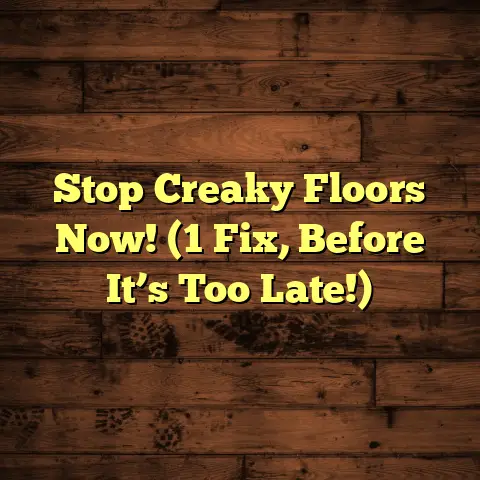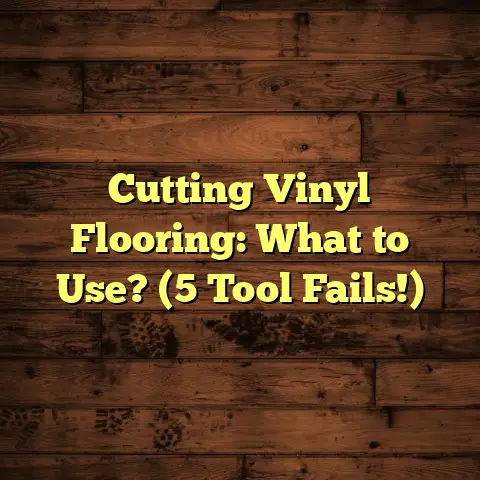Laminate Moisture Barrier: What To Use? (1 Mistake!)
These days, everyone’s thinking about making eco-conscious choices, and that’s awesome!
We want beautiful homes, but we also want to be kind to the planet, right?
Laminate flooring has become super popular, and for good reason.
It looks great, it’s easy on the wallet, and you can install it yourself!
But here’s the thing: laminate and moisture? Not exactly best friends.
That’s where moisture barriers come in – they’re the unsung heroes of a long-lasting, beautiful laminate floor.
Think of them as the bodyguard for your flooring, protecting it from sneaky water damage.
In this article, I’m going to walk you through everything you need to know about choosing the right moisture barrier.
We’ll look at different types, materials, and even the biggest mistake I see homeowners making.
So, grab a coffee, and let’s dive in!
Section 1: Understanding Laminate Flooring
Okay, let’s start with the basics: What is laminate flooring, anyway?
It’s basically a multi-layered synthetic flooring product.
Think of it like a high-tech sandwich:
-
Wear Layer: The top layer, super tough and protects against scratches and stains.
-
Design Layer: This is where the magic happens – a high-resolution image that looks like real wood, stone, or tile.
Core Layer: Usually made of high-density fiberboard (HDF) or medium-density fiberboard (MDF).
This gives the plank its strength and stability.-
Backing Layer: The bottom layer that provides a moisture barrier (though not always enough!) and helps stabilize the plank.
What’s so great about laminate? Well, a few things:
-
Easy Installation: Most laminate floors use a click-lock system, making them DIY-friendly.
-
Cost-Effective: Compared to hardwood or tile, laminate is much more affordable.
-
Design Variety: You can find laminate that mimics almost any natural material, from rustic oak to sleek marble.
Durability: That wear layer is tough stuff!
It can handle kids, pets, and everyday wear and tear.
But here’s the catch: that core layer, usually HDF or MDF, is really susceptible to moisture.
When it gets wet, it can warp, swell, and even grow mold.
Trust me, I’ve seen it happen, and it’s not pretty.
A flooded basement can ruin a laminate floor in a matter of days.
And let’s not forget about the environmental impact.
The production of laminate flooring can involve deforestation and the use of chemicals.
Choosing the right moisture barrier can actually help mitigate some of these effects.
How?
By extending the lifespan of your floor, you reduce the need for replacements and minimize waste.
Plus, some moisture barriers are made from recycled materials, which is a huge win for the planet!
Section 2: The Role of a Moisture Barrier
So, what exactly is a moisture barrier, and why do you need one?
Simply put, it’s a material that prevents moisture from seeping up from the subfloor and damaging your laminate flooring.
Think of it as a raincoat for your floor.
It sits between the subfloor (usually concrete or plywood) and the laminate planks, creating a protective shield.
There are several types of moisture barriers commonly used with laminate:
Polyethylene Sheets: These are thin plastic sheets, usually 6-mil thick.
They’re affordable and provide a basic level of moisture protection.-
Foam Underlayment with Moisture Barrier: This is a popular option because it provides both cushioning and moisture protection.
Some foam underlayments have a built-in polyethylene layer.
-
Specialized Moisture Barrier Products: These are more advanced products designed for specific situations, like high-moisture environments.
Some examples include liquid-applied barriers or thicker, more durable membranes.
So, which one is the most effective? It depends on your specific situation.
Polyethylene sheets are a good basic option, but they don’t offer any cushioning.
Foam underlayments are great for adding comfort and reducing noise, but their moisture barrier might not be as robust as a dedicated product.
Specialized products are the best choice for high-moisture environments, but they can be more expensive.
Here’s a quick comparison table:
No matter which type you choose, proper installation is crucial.
A poorly installed moisture barrier is like a raincoat with holes – it won’t do much good!
Make sure to overlap the seams, seal them with tape, and follow the manufacturer’s instructions carefully.
I’ve seen so many floors ruined because the moisture barrier was installed incorrectly.
Don’t let that happen to you!
Section 3: Materials for Moisture Barriers
Now, let’s talk about the materials that these moisture barriers are made of.
This is where things get interesting, especially when you start thinking about sustainability.
Polyethylene Sheets: This is the most common and affordable option.
Polyethylene is a type of plastic that’s durable and water-resistant.- Pros: Affordable, readily available, effective moisture barrier.
- Cons: Not eco-friendly (made from petroleum), doesn’t provide cushioning.
-
Environmental Considerations: Polyethylene is not biodegradable and can contribute to plastic waste.
However, some polyethylene sheets are made from recycled materials, which is a better option.
-
Cork: This is a natural, renewable material harvested from the bark of cork oak trees.
- Pros: Eco-friendly, naturally resistant to moisture, provides cushioning and insulation.
- Cons: More expensive than polyethylene, can be susceptible to mold if not properly treated.
-
Environmental Considerations: Cork is a sustainable material that can be recycled.
It’s a great choice if you’re looking for a green option.
-
Foam Underlayment: This comes in various types, including polyethylene foam, polyurethane foam, and recycled foam.
- Pros: Provides cushioning, reduces noise, some types have built-in moisture barriers.
- Cons: Moisture barrier may not be as effective as a dedicated product, some foams are not eco-friendly.
-
Environmental Considerations: Look for foam underlayments made from recycled materials or with low VOC emissions.
VOCs (volatile organic compounds) are chemicals that can off-gas and affect indoor air quality.
Specialized Moisture Barrier Products: These are innovative options designed for specific needs.
For example, there are liquid-applied moisture barriers that you can roll onto the subfloor.
There are also thicker, more durable membranes made from advanced materials.
- Pros: Excellent moisture protection, can be tailored to specific environments.
- Cons: Can be expensive, may require professional installation.
- Environmental Considerations: Varies depending on the product.
Look for eco-friendly options with low VOC emissions and recycled content.
Here’s a table summarizing the pros and cons:
When choosing a material, think about your budget, your environmental concerns, and the specific needs of your project.
Do you need extra cushioning? Are you concerned about VOCs?
Answering these questions will help you narrow down your options.
Section 4: The Common Mistake in Selecting Moisture Barriers
Okay, now let’s talk about the big mistake I see homeowners making when choosing a moisture barrier.
Are you ready for it?
It’s choosing a moisture barrier that’s not compatible with their specific environment.
I know, it sounds simple, but trust me, it’s a huge problem!
Think about it: a basement is a completely different environment than a main-level living room.
Basements tend to be more humid and prone to moisture intrusion from the ground.
A basic polyethylene sheet might be fine for a main-level room, but it’s probably not going to cut it in a basement.
I once worked on a project where the homeowner installed laminate flooring in their basement using only a thin polyethylene sheet as a moisture barrier.
Within a year, the flooring started to warp and buckle.
When we pulled it up, we found mold growing underneath.
The homeowner had to replace the entire floor, costing them thousands of dollars.
That’s a costly mistake!
Here are some factors to consider when assessing your environment:
-
Humidity Levels: Is your home generally humid? Do you live in a rainy climate?
Vapor Barrier: Do you have a vapor barrier installed in your subfloor?
A vapor barrier is a layer of material that prevents moisture from passing through the subfloor.If you have a vapor barrier, you might not need as robust of a moisture barrier under your laminate.
Subfloor Type: Is your subfloor concrete or wood?
Concrete is more porous and can wick up moisture from the ground.
To avoid this mistake, take the time to assess your environment before you choose a moisture barrier.
If you’re not sure, consult with a flooring professional.
They can help you determine the best type of moisture barrier for your specific situation.
Here’s a quick guide:
-
Main Level, Low Humidity: Polyethylene sheet or foam underlayment with a basic moisture barrier.
-
Main Level, High Humidity: Foam underlayment with a robust moisture barrier or a specialized moisture barrier product.
-
Basement, Low Humidity: Foam underlayment with a robust moisture barrier or a specialized moisture barrier product.
-
Basement, High Humidity: Specialized moisture barrier product, such as a liquid-applied barrier or a thick membrane.
Section 5: Eco-Conscious Choices in Moisture Barriers
Alright, let’s talk about making eco-conscious choices when it comes to moisture barriers.
As I mentioned earlier, the flooring industry can have a significant environmental impact.
Choosing sustainable materials is a great way to minimize your footprint.
Here are some tips for identifying environmentally friendly moisture barrier options:
-
Look for Certifications: Certifications like GREENGUARD and FSC (Forest Stewardship Council) indicate that a product meets certain environmental standards.
GREENGUARD certification means that a product has low VOC emissions.
FSC certification means that wood products come from responsibly managed forests.
-
Check for Recycled Content: Look for moisture barriers made from recycled materials, such as recycled foam or recycled plastic.
-
Consider Natural Materials: As we discussed earlier, cork is a great natural and renewable option.
Research Companies: Look for companies that prioritize sustainability in their manufacturing processes.
Do they use renewable energy?
Do they minimize waste?
Here are some companies that are known for their eco-friendly flooring products:
[Company Name 1]: Offers a range of flooring products made from recycled materials.
[Link to company website].-
[Company Name 2]: Specializes in cork flooring and underlayment. [Link to company website].
-
[Company Name 3]: Committed to sustainable forestry practices. [Link to company website].
Using recycled materials in moisture barriers is a great way to reduce waste and conserve resources.
For example, recycled foam underlayment is often made from recycled tires or other post-consumer waste.
This helps divert these materials from landfills and gives them a new life.
Choosing eco-friendly moisture barriers is not just good for the environment, it’s also good for your health.
Products with low VOC emissions can improve indoor air quality and reduce the risk of respiratory problems.
Section 6: Installation Tips for Moisture Barriers
Okay, you’ve chosen the right moisture barrier for your environment and your budget.
Now it’s time to install it!
Here’s a step-by-step guide to help you do it right:
Prepare the Subfloor: Make sure the subfloor is clean, dry, and level.
Remove any debris, nails, or screws.If the subfloor is uneven, you may need to use a self-leveling compound to create a smooth surface.
-
Roll Out the Moisture Barrier: Unroll the moisture barrier and lay it flat on the subfloor.
Overlap the seams by at least 6 inches.
-
Seal the Seams: Use moisture-resistant tape to seal the seams.
Make sure the tape is specifically designed for this purpose.
-
Trim the Edges: Use a utility knife to trim the edges of the moisture barrier to fit the room.
-
Install the Laminate Flooring: Follow the manufacturer’s instructions for installing the laminate flooring.
Here are some common pitfalls to avoid:
Not overlapping the seams: This is a big one!
If the seams aren’t properly overlapped, moisture can seep through.Using the wrong tape: Don’t use just any tape to seal the seams.
Use moisture-resistant tape specifically designed for this purpose.-
Not following manufacturer’s instructions: Always read and follow the manufacturer’s instructions for both the laminate flooring and the moisture barrier.
They know their products best!
Here’s a quick checklist:
- [ ] Subfloor is clean, dry, and level
- [ ] Moisture barrier is rolled out and flat
- [ ] Seams are overlapped by at least 6 inches
- [ ] Seams are sealed with moisture-resistant tape
- [ ] Edges are trimmed to fit the room
- [ ] Manufacturer’s instructions are followed
Remember, proper installation is key to ensuring the optimal performance of your moisture barrier.
Take your time, be careful, and don’t be afraid to ask for help if you need it.
Conclusion
So, there you have it!
Everything you need to know about choosing and installing a moisture barrier for your laminate flooring.
We’ve covered the importance of moisture barriers, the different types of materials available, the common mistake to avoid, and how to make eco-conscious choices.
Remember, selecting the right moisture barrier is crucial for preventing damage and extending the lifespan of your laminate flooring.
And by making eco-conscious choices, you can not only protect your floor but also contribute to environmental sustainability.
So, take the time to assess your environment, research your options, and choose a moisture barrier that’s right for you.
Your floor (and the planet) will thank you!
Now, go forth and create a beautiful, long-lasting, and eco-friendly floor!





